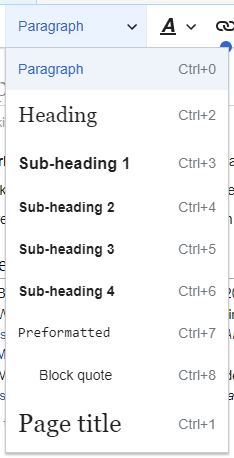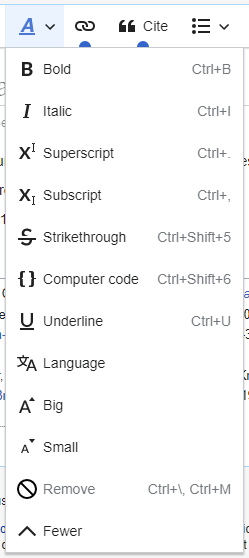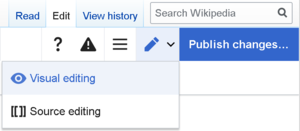Help:VisualEditor/User guide: Difference between revisions
(begin the process of copying this page over from mw:Help:VisualEditor/User_guide/en) |
(No difference)
|
Revision as of 17:08, 25 August 2019
Opening the visual editor
Getting started: the visual editor's toolbar
| The visual editor's toolbar appears at the top of the screen when you begin editing. It includes some familiar icons: | |
| Undo and Redo the changes you have made. | |
 |
Headings pull-down menu: allows you to change how the paragraph is formatted. To change the style of a paragraph, put your cursor in the paragraph and select an item in this menu (you don't have to highlight any text). Section titles are formatted "Heading", and subsections are "Sub-heading 1", "Sub-heading 2", and so on. The normal format for text is "Paragraph". |
 |
Formatting: Pressing the "A" opens a menu.
If you have not selected any text, then when you press the "A" to open the menu, and then select an item, that formatting will apply to the text that you start typing, from wherever your cursor is located. |
 |
Linking tool: The chain icon is the linking tool. Pressing on it (usually after selecting some text) opens the link dialog. |
 |
Cite menu: The "Cite" menu is used to add inline citations (also called "footnotes" or "references"). All projects have access to basic reference formatting and the ability to reuse citations by using this menu. It also gives users quick access to local citation templates, if these are enabled on their wiki.
(Instructions for adding local citation templates to the Cite menu at a specific wiki are available at mw:VisualEditor/Citation tool.) |
 |
⧼citoid-citefromidtool-title⧽ button: If the citoid service is enabled on your wiki, then you will see a ⧼citoid-citefromidtool-title⧽ button instead of a Cite menu.
The citoid service tries to fill out citation templates automatically. |
 |
Lists and indentation: The first two items allow you to format text as either a "Bullet list" or a "Numbered list". The last two items allow you to decrease or increase the indentation level of list items. |
 |
Insert: The "Insert" menu may be different on some projects. Below is a list of all options that may appear.
|
| Special character insertion: The "Special character" (Ω) icon is next to the "Insert" menu. When pressed, it displays a dialog showing many special characters. By pressing on a specific character, you place it into the text. These special characters include some standard symbols, diacritics, and mathematical symbols. (This list may be customized locally. See mw:VisualEditor/Special characters for instructions.) | |
| The Edit notices button displays any notices for the page. | |
 |
The Page options menu is to the left of the Publish changes button and the Switch editor menu. On this menu there is a button to open an Options dialog with the following (left side) tabs:
The tabs of the Options dialog are also displayed in the Page options menu and can be opened by clicking on it. Furthermore the Page options menu contains the button View as right-to-left and the button Find and replace which opens a dialog where you can insert characters, terms or Regular expressions you are searching for and those to replace them with, together with several buttons for options. |
| The switch to source editing button is next to the Publish changes button. It allows you to switch to the wikitext editor. | |






